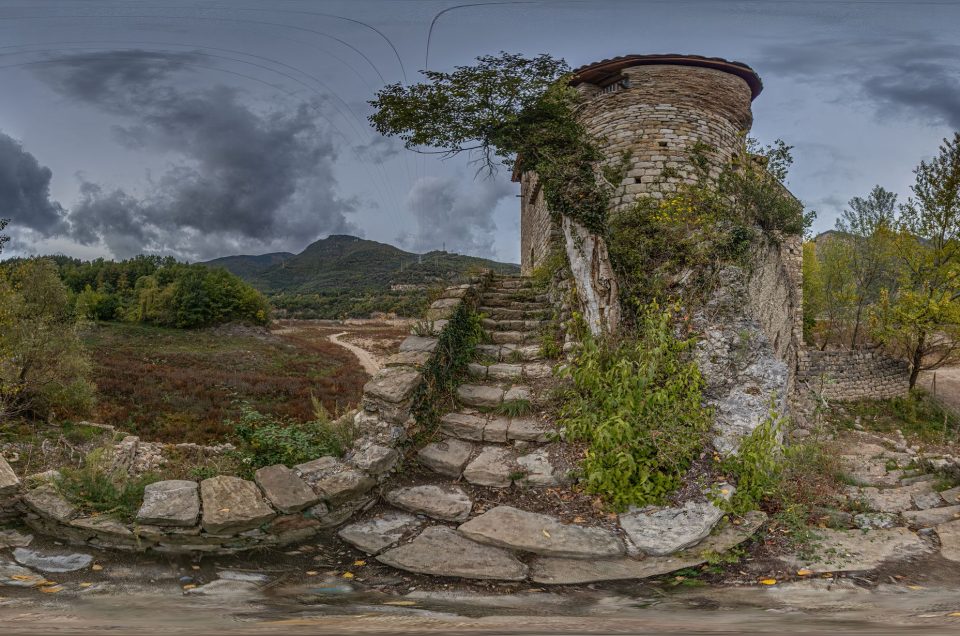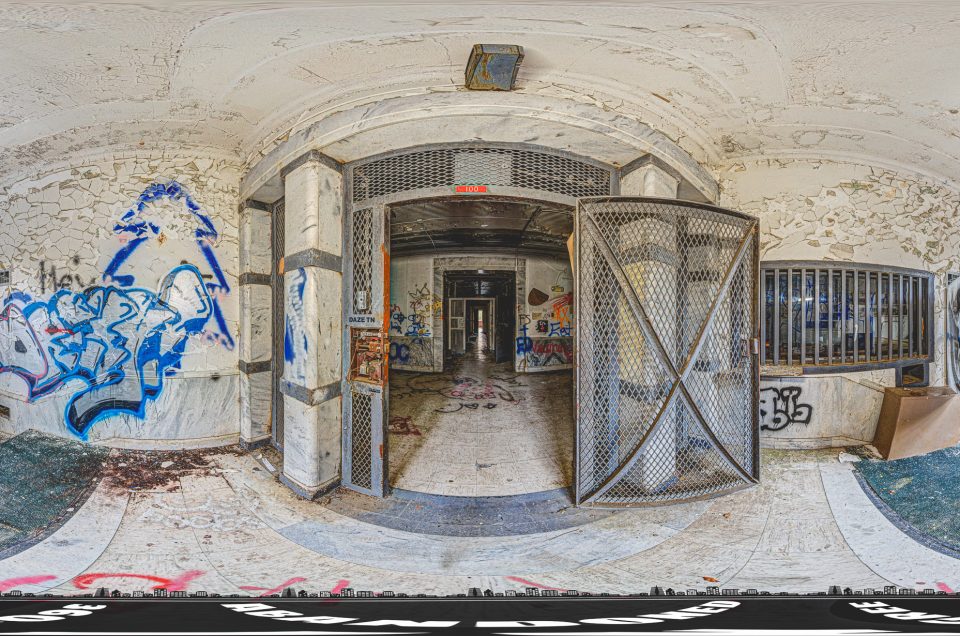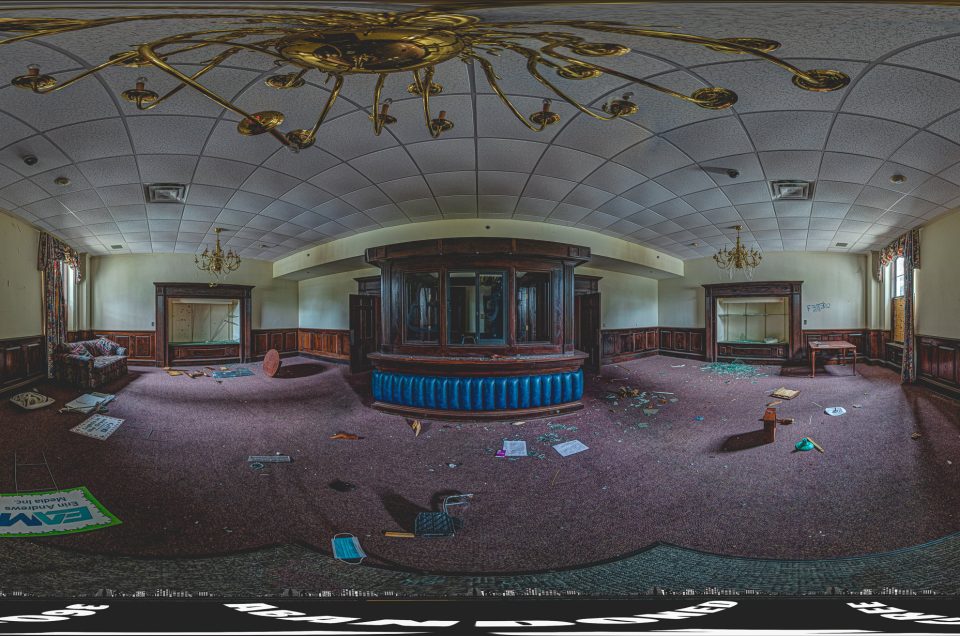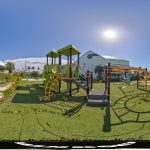Discovering the Abandoned Palace of Culture in Jermuk: History, Mystery, and Urban Exploration in Armenia
Urban explorers can now experience a unique digital journey with a 360-degree self-guided virtual tour of the abandoned and decaying Palace of Culture in Jermuk, Armenia. This immersive tour, available through Google Maps Street View, allows you to scrutinize every detail of this once vibrant landmark as it reveals the echoes of its storied past.
Step into the eerie atmosphere of a forgotten relic and explore its time-worn corridors and crumbling facades from the comfort of your own space. This interactive experience is tailored for those passionate about urban exploration, offering an unparalleled glimpse into the mysterious world of the Palace of Culture in Jermuk.
Photo by: Tumanyan Town
Urban explorers and history enthusiasts alike have long been fascinated by relics of the past that tell the story of a bygone era. Among these intriguing sites is the abandoned Palace of Culture in Jermuk, Armenia—a structure that holds secrets of its former glory, cultural gatherings, and dramatic decline. In this in-depth blog post, we will delve into the history, architectural beauty, cultural significance, and eventual abandonment of this unique building. Whether you are planning urban exploring in Armenia or simply curious about the stories hidden in forgotten spaces, this article offers a comprehensive look at one of Armenia’s most mysterious abandoned landmarks.
A Glimpse into the Past
The Palace of Culture in Jermuk was constructed during a time when community centers were a symbol of cultural unity and artistic expression in the region. Built in the early 1970s, this imposing structure was designed to serve as a hub for the arts and community events in a town famed for its therapeutic mineral springs and scenic beauty. For decades, the building was a vibrant gathering spot where local residents, artists, and visitors alike could enjoy theatrical performances, musical concerts, and a wide range of cultural programs.
When and Why It Was Built
During the Soviet era, government policies emphasized the creation of cultural institutions that could foster community spirit and promote artistic endeavors. The Palace of Culture in Jermuk was commissioned as part of this initiative. Records indicate that construction began in the late 1960s, and the building was completed by the early 1970s. The architecture of the building reflected a blend of utilitarian design and decorative elements common to Soviet-era cultural institutions. With spacious auditoriums, art galleries, and multipurpose halls, the Palace of Culture was built to inspire creativity and host a variety of public events.
The structure was not just a building but a symbol of progress and unity. It was intended to be a beacon of culture in a town that was rapidly developing into a popular resort destination. Its grand design and central location in Jermuk made it an essential part of the town’s social and cultural fabric. For nearly three decades, it was the stage upon which countless performances and community events unfolded.
The Architectural Marvel of a Bygone Era
Design and Construction
Architecturally, the Palace of Culture in Jermuk exemplifies the bold vision of its time. The design of the building reflects a combination of modernist influences and local architectural traditions. Large windows allowed natural light to fill the spacious interiors, and the exterior featured ornamental motifs that celebrated both the industrial progress and artistic aspirations of the era.
The structure was built using a mix of reinforced concrete and local stone, materials that were readily available and symbolized both durability and a connection to Armenian heritage. Over the years, its imposing façade and expansive interiors became a canvas for artistic expression, with murals and decorative carvings that told stories of Armenian history and Soviet achievements.
Key Features of the Building
- Spacious Auditoriums: Designed to host large audiences, the auditoriums were the heart of the Palace of Culture. They hosted everything from theatrical performances to public lectures, making them vital community spaces.
- Art Galleries and Exhibition Halls: These areas were dedicated to showcasing local art and cultural artifacts, providing a platform for Armenian artists to express their creativity.
- Multipurpose Halls: Flexible spaces that could be adapted for concerts, dance recitals, and community meetings, reflecting the building’s role as a cultural melting pot.
- Cultural Symbolism: Beyond its physical attributes, the building carried a symbolic significance. It was a testament to the era’s belief in the transformative power of art and community engagement.
This architectural marvel not only served its practical purpose but also became a landmark in its own right, inspiring local pride and admiration among visitors.
The Palace in Its Prime: A Cultural Hub
Who Used the Property
Throughout its active years, the Palace of Culture in Jermuk was a bustling center of activity. It was frequented by a diverse group of people who contributed to its rich legacy:
- Local Residents: For the people of Jermuk, the Palace was more than a building—it was a place where community bonds were strengthened. Families attended performances, and neighbors gathered for public celebrations and festivals.
- Artists and Performers: From theater troupes and musicians to visual artists, the building was a platform for creative expression. It provided local talent with a venue to showcase their skills and gain recognition.
- Students and Educators: The educational programs and cultural workshops hosted within its walls enriched the intellectual and creative lives of the younger generation.
- Tourists and Visitors: As Jermuk grew in popularity as a resort town, the Palace attracted visitors from far and wide, eager to experience a taste of Armenian culture and the region’s artistic traditions.
The Role of the Palace in Community Life
During its heyday, the Palace of Culture was a vibrant epicenter of community life. It hosted an array of events that brought together people from all walks of life. One could attend an afternoon performance, participate in art exhibitions, or join a community dance event. The building played a pivotal role in preserving and promoting Armenian cultural heritage at a time when modern influences were beginning to seep into traditional practices.
The cultural programs organized within the Palace not only entertained but also educated. They offered a glimpse into the rich history and artistic traditions of Armenia, creating an environment where both history and modernity coexisted harmoniously. This spirit of cultural celebration made the Palace a cherished landmark for nearly thirty years.
The Downfall: Why the Palace Was Abandoned
Shifts in Political and Economic Landscapes
The transition from the Soviet era to independent Armenia brought significant changes to the country’s economic and political landscape. Many cultural institutions that were once supported by the state faced funding cuts and bureaucratic challenges. The Palace of Culture in Jermuk was no exception. With the dissolution of the Soviet Union, the emphasis on grand cultural centers diminished, and many such properties found themselves without the financial support needed to maintain them.
Local government budgets were stretched thin as the country navigated the economic uncertainties of a new political reality. As a result, maintenance and operational costs for large cultural buildings became increasingly difficult to manage. The once-thriving Palace of Culture gradually fell into disrepair as funds were redirected to more immediate needs.
Changing Cultural Priorities
The decline of the Palace was also influenced by shifting cultural priorities. The rise of modern entertainment, the advent of new media, and changes in the way communities engaged with the arts led to a decline in attendance at traditional cultural events. What was once a focal point for communal gatherings began to lose its appeal to a younger generation that sought new forms of recreation and artistic expression.
Furthermore, the building’s management struggled to adapt to the evolving cultural landscape. With a focus on preserving its historical significance rather than updating its facilities to meet modern demands, the Palace gradually lost relevance in the community. This disconnect between past glory and present needs contributed significantly to its eventual abandonment.
The Process of Abandonment
By the early 2000s, the signs of neglect were visible to anyone passing by the once-proud edifice. Crumbling facades, broken windows, and overgrown surroundings marked the end of an era. As maintenance efforts ceased, the building quickly became a favorite destination for urban exploring in Armenia. What was once a center of lively cultural exchange transformed into a silent monument to a lost era.
Local rumors and anecdotes began to circulate about the building’s history and the events that led to its abandonment. Some tales spoke of missed opportunities for restoration, while others hinted at bureaucratic infighting that left the building stranded in a limbo of neglect. Whatever the precise details, the outcome was clear: the Palace of Culture in Jermuk became an abandoned relic—a symbol of both historical splendor and the harsh realities of economic transition.
Urban Exploring in Armenia: The Allure of Abandoned Spaces
Why Urban Explorers Are Drawn to Abandoned Sites
Urban exploring in Armenia has gained popularity among adventurers and history buffs alike. Abandoned sites like the Palace of Culture in Jermuk offer a unique glimpse into the past. They are a canvas of time where art, decay, and nature converge to tell stories that modern buildings simply cannot. The allure of exploring such sites lies in the thrill of discovery—uncovering layers of history that have been left behind, and experiencing the atmosphere of spaces once filled with life and activity.
For urban explorers, abandoned locations represent more than just old structures; they are relics of a time when community values and cultural heritage were expressed in grand architectural endeavors. The Palace of Culture, with its rich history and striking architecture, serves as a perfect case study in the phenomenon of urban decay and cultural transformation.
Safety and Legal Considerations
While the excitement of urban exploring in Armenia is undeniable, it is important to approach such adventures with caution and respect. Abandoned buildings can pose significant risks, including unstable structures, hazardous materials, and poor lighting. Here are some essential tips for those interested in visiting the abandoned Palace of Culture in Jermuk:
- Research and Plan Ahead: Before visiting, gather as much information as possible about the site. Local urban exploration forums and historical records can provide valuable insights into the building’s condition and history.
- Wear Appropriate Gear: Sturdy footwear, protective clothing, and a reliable flashlight are a must. Avoid loose clothing that might get caught on debris.
- Never Go Alone: Always explore with a companion, and inform someone of your plans and expected return time.
- Respect Private Property: Ensure that your exploration does not violate any laws or trespass on restricted areas. Always ask for permission if required.
- Document Responsibly: Photography is a popular part of urban exploring, but be mindful of your surroundings and the preservation of the site.
These precautions help ensure that the thrill of exploring abandoned sites does not come at the expense of personal safety or the integrity of the property.
The Growing Community of Urban Explorers in Armenia
In recent years, urban exploring in Armenia has blossomed into a community of like-minded adventurers. Social media platforms and online forums are filled with stories, photographs, and tips shared by explorers who have ventured into abandoned sites across the country. The Palace of Culture in Jermuk stands out as a popular destination among these explorers, its history and aesthetic allure attracting visitors from both Armenia and abroad.
This growing community is not only interested in the thrill of discovery but also in the preservation of cultural memory. Many urban explorers document their journeys and the history behind each site, contributing to a collective effort to keep the stories of abandoned structures alive. The shared passion for uncovering forgotten relics has even inspired local initiatives aimed at raising awareness about the need for historical preservation in Armenia.
The Current State of the Palace of Culture in Jermuk
A Snapshot of Decay and History
Today, the abandoned Palace of Culture in Jermuk stands as a silent witness to the passage of time. The vibrant community hub it once was has given way to a melancholic aura of decay and forgotten memories. Visitors who arrive at the site are greeted by crumbling walls, faded murals, and an overwhelming sense of history in every corner. Nature has started to reclaim the area, with overgrown vegetation seeping through cracks in the concrete, creating a striking contrast between man-made structures and the raw force of nature.
The building’s interior, once filled with the sounds of music and laughter, now echoes with the whispers of the past. Every corridor and room seems to tell its own story, from the vibrant days of community performances to the slow decline marked by neglect and abandonment. Urban explorers who have visited the site speak of the surreal experience of stepping into a space that holds both beauty and melancholy.
Local Perspectives and Cultural Significance
For local residents, the abandoned Palace of Culture is a bittersweet reminder of a time when cultural events were a cornerstone of community life. Many older residents recall attending events and celebrations in the building, and they share personal anecdotes that add a human dimension to its history. These stories contribute to the building’s mythos, creating a tapestry of memories that is as much about the people as it is about the structure itself.
In addition to its cultural significance, the building also serves as a valuable piece of architectural history. It is a testament to the design philosophies of the Soviet era and offers urban explorers a rare glimpse into a period that shaped much of modern Armenian identity. As such, the Palace of Culture in Jermuk continues to draw the attention of historians, architects, and cultural preservationists who advocate for its recognition and potential restoration.
Future Prospects: Restoration or Further Decay?
The future of the abandoned Palace of Culture in Jermuk remains uncertain. There have been occasional discussions among local officials and cultural preservation groups about the possibility of restoring the building and repurposing it for modern use. However, challenges such as funding, bureaucratic hurdles, and the sheer scale of renovation required have so far prevented any concrete plans from materializing.
Some urban explorers and local historians hope that increased attention and interest might eventually spur efforts to preserve the building as a cultural landmark. Such restoration projects, if undertaken responsibly, could transform the Palace into a museum or community center once again, allowing its rich history to be celebrated and shared with future generations. Until then, the building remains an abandoned relic—a powerful reminder of the impermanence of human endeavors and the ever-changing face of cultural heritage.
Stories and Anecdotes from the Past
Legendary Performances and Memorable Events
Over the years, the Palace of Culture in Jermuk was host to a variety of memorable events that contributed to its storied past. Local legends recount extraordinary performances by renowned Armenian theater troupes and musical ensembles. These events not only provided entertainment but also fostered a sense of unity and pride among the town’s residents. Stories of impromptu street performances, vibrant art exhibitions, and community festivals are often recounted by those who once frequented the building.
One popular anecdote involves a celebrated local musician whose performance in the Palace was so moving that it left a lasting impression on the audience, many of whom still recall the emotional power of that night. Such stories add layers of meaning to the abandoned structure, transforming it from a mere building into a repository of collective memory and cultural significance.
Personal Reflections from Urban Explorers
Urban explorers who have visited the site often share personal reflections on their experiences. Many describe a profound sense of connection to the past when walking through the decaying halls of the Palace of Culture. The combination of art, architecture, and history creates an atmosphere that is both haunting and inspiring. Explorers note that the building, though abandoned, still exudes a certain warmth and character—echoes of the laughter, applause, and conversations that once filled its spaces.
For many, visiting the Palace is not just about thrill-seeking; it is about paying homage to a part of Armenian cultural heritage. They document their experiences through photography and detailed narratives, contributing to an online archive of urban exploring in Armenia that celebrates both the beauty and the melancholy of abandoned places.
Practical Tips for Visiting the Abandoned Palace of Culture in Jermuk
How to Get There
Located in the scenic town of Jermuk in southern Armenia, the Palace of Culture is accessible by road. Visitors interested in urban exploring in Armenia should plan their journey carefully. The town is known for its mineral springs and picturesque landscapes, making it a worthwhile destination even beyond the urban exploration of its abandoned sites. Local transport options and guided tours are available, though independent explorers often prefer to drive themselves to ensure flexibility.
What to Bring
When planning a visit to this abandoned site, preparation is key. Here are some essentials to consider:
- Protective Clothing: Given the state of decay, it is advisable to wear durable clothing that can protect against broken glass, sharp edges, and overgrown vegetation.
- Reliable Footwear: A sturdy pair of boots with good grip is essential to navigate the uneven and potentially slippery surfaces.
- Flashlight or Headlamp: Many parts of the building may be poorly lit, so having a powerful light source is crucial.
- Camera and Notebook: Document your findings and experiences. Many urban explorers find that capturing the aesthetic and historical details of the site adds greatly to the adventure.
- First-Aid Kit: Always be prepared for minor injuries or mishaps that may occur in abandoned structures.
- Portable Charger: Ensure that your phone or camera remains charged throughout your exploration.
Exploring Responsibly
Respect for the site is paramount. While the allure of abandoned buildings is strong, it is important to tread carefully and preserve the integrity of the structure for future explorers. Avoid vandalism, do not remove artifacts, and always follow any local guidelines regarding access. Remember, sites that are abandoned in Armenia are often rich in history and cultural significance, and every visitor has a responsibility to act as a respectful historian and caretaker.
Reflections on the Intersection of History and Urban Exploration
The story of the abandoned Palace of Culture in Jermuk is a powerful reminder of the dynamic nature of human achievement. What was once a vibrant center for art, culture, and community has now become a silent monument to change and transition. For urban explorers, this transformation holds a unique appeal. The juxtaposition of past vibrancy against the backdrop of decay provides a tangible link to history—a connection that is both visually striking and emotionally resonant.
Urban exploring in Armenia offers a window into the complex layers of the country’s heritage. Each abandoned site tells a story not only of neglect but also of the inevitable evolution of society. In the case of the Palace of Culture, every cracked wall and faded mural speaks to the resilience of cultural memory. Despite the passage of time and the challenges of modernity, the echoes of past celebrations and communal gatherings continue to inspire those who venture into its abandoned corridors.
The Broader Cultural and Historical Context
Armenia’s Rich Tapestry of History
To fully appreciate the significance of the Palace of Culture in Jermuk, it is important to understand its place within Armenia’s broader cultural and historical context. Armenia is a country with a storied past that dates back thousands of years, characterized by a unique blend of influences from ancient civilizations, Christian heritage, and modern Soviet history. The architectural and cultural achievements seen in structures like the Palace of Culture are part of a larger narrative of resilience, creativity, and transformation.
The building stands as a representation of a period when state-sponsored cultural projects were seen as essential for nation-building. Its construction during the Soviet era was not an isolated phenomenon; similar institutions were established in various parts of the country, each contributing in its own way to the preservation and promotion of Armenian arts and culture.
The Impact of Political Change
The decline of such cultural institutions is deeply intertwined with the political and economic changes that swept through the region after the fall of the Soviet Union. As Armenia transitioned to independence, many state-supported initiatives lost their footing, leading to a wave of abandonment across the nation. The Palace of Culture in Jermuk is emblematic of this broader trend—once a symbol of cultural progress, it now stands as a reminder of the challenges faced by heritage sites in a rapidly changing world.
This narrative resonates deeply with urban explorers, who often seek to understand the forces that shape our environments. Exploring abandoned sites in Armenia is not just an adventure; it is an opportunity to engage with history on a personal level and to reflect on the delicate balance between progress and preservation.
Personal Stories and Community Engagement
The Role of Storytelling in Urban Exploration
One of the most compelling aspects of exploring abandoned places like the Palace of Culture in Jermuk is the opportunity to hear personal stories and firsthand accounts of the building’s past. Many locals have grown up with the echoes of the Palace’s former life, and their recollections add a rich, human dimension to the historical record. Storytelling has become an integral part of urban exploring in Armenia, with explorers and former residents alike sharing their memories through blogs, social media, and community events.
These personal narratives help to bridge the gap between history and present-day exploration. They provide context to the physical remnants of the past, transforming cold, decaying structures into living repositories of community memory and cultural heritage.
Inspiring Future Preservation Efforts
The growing community of urban explorers has also sparked discussions about the future of abandoned sites in Armenia. There is a rising awareness of the need to preserve these historical treasures, not only for their architectural value but also for the cultural insights they offer. Some local groups have started initiatives to document and safeguard abandoned landmarks, hoping to raise funds or attract government support for restoration projects.
The abandoned Palace of Culture in Jermuk, with its rich history and architectural grandeur, has become a focal point for such discussions. While its future remains uncertain, the passion and dedication of those who cherish its legacy continue to inspire efforts toward preservation and responsible urban exploration.
Embracing the Legacy of the Palace of Culture
Celebrating a Storied Past
In many ways, the abandoned Palace of Culture in Jermuk represents a microcosm of Armenia’s journey through the 20th century—a story of artistic ambition, communal celebration, and the inevitable changes brought by political and economic upheaval. While the building itself may now be quiet and forgotten by mainstream society, its legacy lives on in the hearts of those who experienced its vibrant past and those who explore its remnants today.
Urban explorers who visit the site often speak of a profound sense of connection to a time when community and culture were central to everyday life. This connection is what makes exploring abandoned sites so meaningful; it is a chance to witness history in its raw, unfiltered form, and to appreciate the enduring impact of art and community on our collective memory.
A Call to Action for Responsible Exploration
As we conclude our journey through the history of the Palace of Culture in Jermuk, we encourage all urban explorers to approach abandoned sites with respect, curiosity, and a commitment to preserving their stories. Whether you are an experienced explorer or someone just beginning to discover the allure of abandoned places in Armenia, remember that every step taken in these historic corridors is a tribute to the cultural legacy they represent.
Take the time to research, plan, and document your experiences. Share your stories and photographs with the broader community so that the legacy of the Palace—and other such landmarks—can be appreciated by future generations. Responsible exploration not only enhances your own experience but also contributes to a collective effort to honor and preserve Armenia’s rich cultural heritage.
Conclusion
The abandoned Palace of Culture in Jermuk stands as a powerful reminder of a bygone era—a time when community centers were the beating heart of cultural expression and artistic innovation. Although it has been abandoned in Armenia for years, the building continues to attract urban explorers and history enthusiasts who are drawn by its architectural beauty, rich past, and the echoes of memories that linger in every crumbling wall and faded mural.
From its construction in the early 1970s to its eventual decline in the wake of economic and cultural shifts, the Palace of Culture has played many roles: as a hub of community activity, a stage for unforgettable performances, and now as a compelling destination for those interested in urban exploring in Armenia. Its story is a testament to the resilience of cultural memory and a reminder that even in decay, there is beauty and history waiting to be rediscovered.
For those who visit this remarkable site, every step taken is an opportunity to connect with the past, to learn from the triumphs and challenges of previous generations, and to contribute to a broader narrative of preservation and respect for cultural heritage. The Palace of Culture in Jermuk may no longer echo with the sounds of celebration and laughter, but it continues to speak volumes about the rich tapestry of Armenian history and the transformative power of art and community.
As you consider planning your next urban exploration adventure, let the story of this abandoned palace inspire you. Dive into its history, appreciate its architecture, and let the silent whispers of the past guide your journey. And remember: every exploration is not just an adventure, but a step toward keeping history alive for those who will follow in your footsteps.
Thank you for reading this comprehensive exploration of the abandoned Palace of Culture in Jermuk. We hope that this detailed account has not only informed you about the building’s fascinating history and cultural significance but also ignited your passion for urban exploring in Armenia. Share your experiences, engage with fellow explorers, and continue to uncover the hidden stories behind Armenia’s most intriguing abandoned sites. Happy exploring!
If you liked this blog post, you might be interested in reading about the Mount Tom Ski Area in Massachusetts, the Church of Saint Pantaleon in Italy, or this abandoned Submarine Bunker in Croatia.
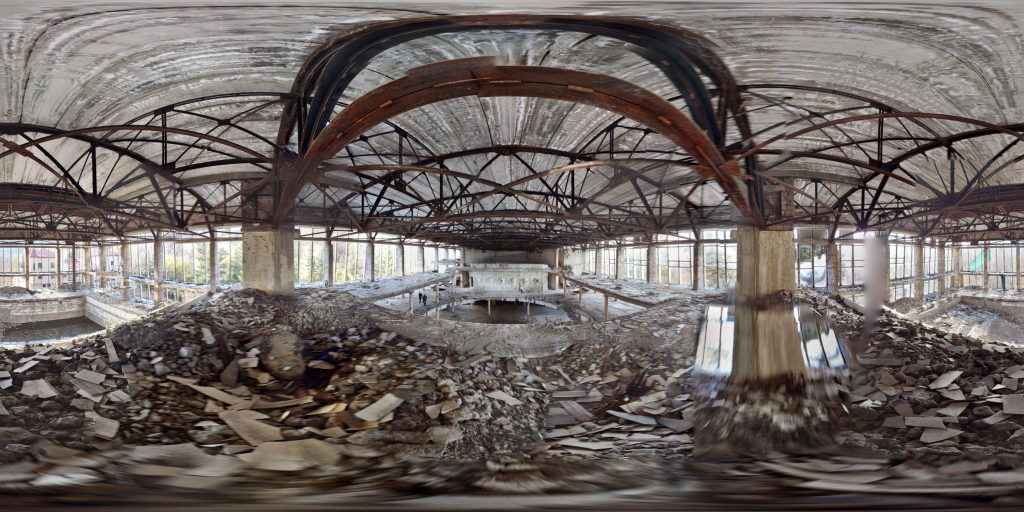
A 360-degree panoramic image captured inside the abandoned Palace of Culture in Jermuk, Armenia. Photo by: Tumanyan Town
Welcome to a world of exploration and intrigue at Abandoned in 360, where adventure awaits with our exclusive membership options. Dive into the mysteries of forgotten places with our Gold Membership, offering access to GPS coordinates to thousands of abandoned locations worldwide. For those seeking a deeper immersion, our Platinum Membership goes beyond the map, providing members with exclusive photos and captivating 3D virtual walkthroughs of these remarkable sites. Discover hidden histories and untold stories as we continually expand our map with new locations each month. Embark on your journey today and uncover the secrets of the past like never before. Join us and start exploring with Abandoned in 360.
Do you have 360-degree panoramic images captured in an abandoned location? Send your images to Abandonedin360@gmail.com. If you choose to go out and do some urban exploring in your town, here are some safety tips before you head out on your Urbex adventure. If you want to start shooting 360-degree panoramic images, you might want to look onto one-click 360-degree action cameras.
Click on a state below and explore the top abandoned places for urban exploring in that state.
